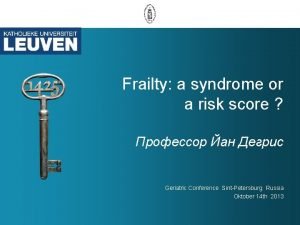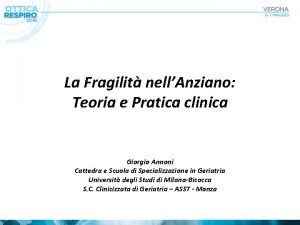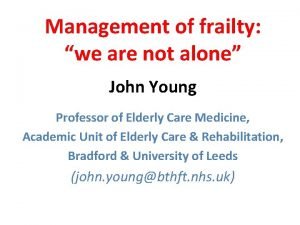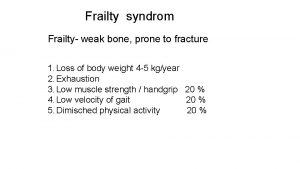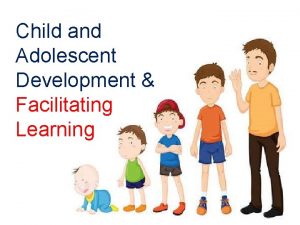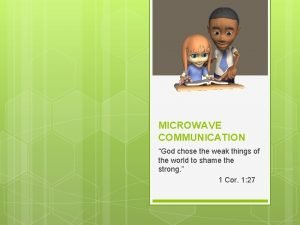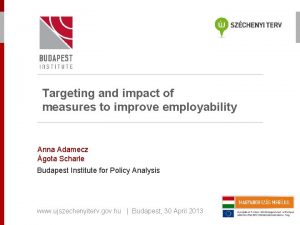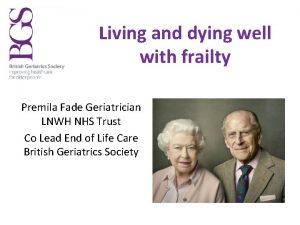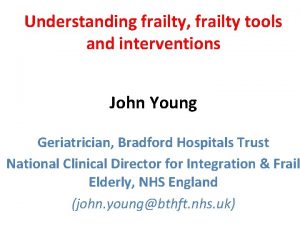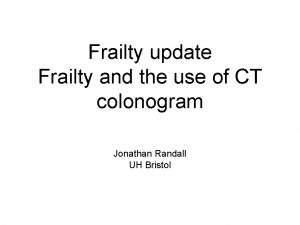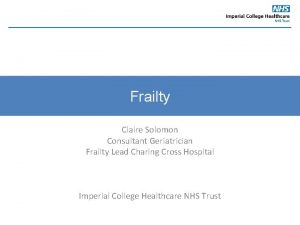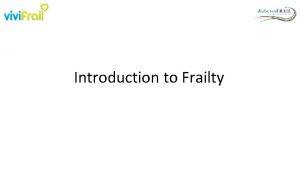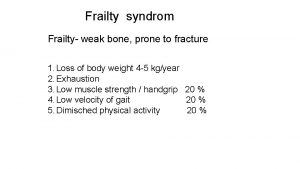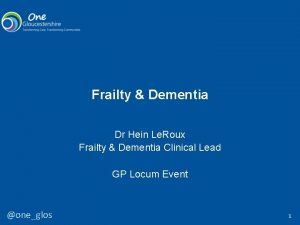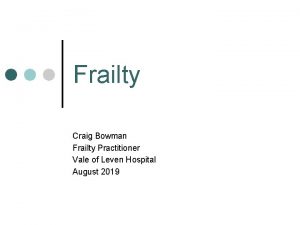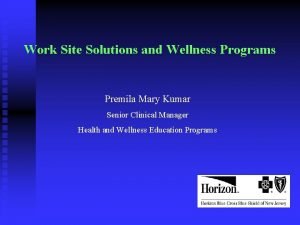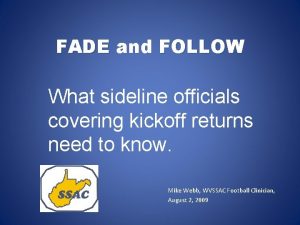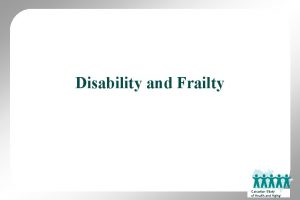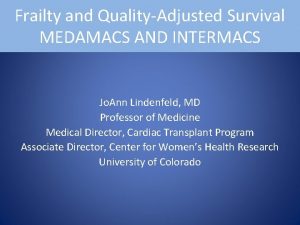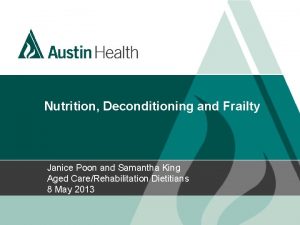Frailty is the futurechallenges and ideas Premila Fade










![Frailty syndromes • 1] Falls e. g. collapse ? cause, legs gave way, ‘FOF- Frailty syndromes • 1] Falls e. g. collapse ? cause, legs gave way, ‘FOF-](https://slidetodoc.com/presentation_image_h/a42f2699aec958d9ba35f2957e82a3d6/image-11.jpg)










- Slides: 21

Frailty is the futurechallenges and ideas Premila Fade Consultant Geriatrician LNWH NHS Trust Lead for end of life care British Geriatrics Society

Ageing population • Older population expansion in England will accelerate next 20 years • Over 65 s will from 17% (2010) to 23% by 2035 • England in 2014: 9. 5 million aged 65+; 471 K aged 90+ • By 2035 there will be 14. 5 million 65+ and 1. 1 million 90+ • 15 million live with a long term condition (LTC) • 58% people with a LTC are over 60 (14% under 40) • A&E attendances by people aged 60+ by two thirds 2007 to 2014 • 2010 -15: 18% in emergency hospital older people admissions 2

The burden of multimorbidity Applying NICE guidelines to a 78 year old woman with previous myocardial infarction, type-2 diabetes, osteoarthritis, COPD, and depression… • • • 11 drugs (and possibly another 10) 9 lifestyle modifications 8 -10 routine primary care appointments 8 -30 psycho-social interventions Smoking cessation appointments Pulmonary rehabilitation “I’d like my life back please!” Hughes et al Age & Ageing 2013

What is frailty?

What is frailty? Minor stressors trigger disproportionate change in health status FUNCTIONAL ABILITY ‘MINOR ILLNESS’ INDEPENDENT Unpredictable recovery

• Frailty is a distinctive health state related to the ageing process in which multiple body systems gradually lose their in-built reserves. • Around 10% of people aged over 65 years have frailty, rising to 40% of those aged over 85 years. • Older people living with frailty are at risk of dramatic changes in their physical and mental wellbeing after an apparently minor event which challenges their health, such as an infection or new medication • Many people with multiple long term conditions also have frailty which may be masked when the focus is on the long term conditions. • Some people are frail but do not suffer from any chronic diseases and may not be known to their GP (until they become bed bound, immobile or delirious as a result of an apparently minor illness). • There is overlap between the management approaches for people with multi-morbidity and those with frailty but these conditions are not identical. • There is also overlap between frailty and physical disability – many people with frailty also have disability, but lots of people with a long term disability do not have frailty.

Frailty phenotype- sacropenia • • • unintentional weight loss Reduced muscle strength Reduced gait speed Self-reported exhaustion and Low energy expenditure. Generally individuals with three or more of the characteristics are said to have frailty

Dalhousie clinical frailty scale (Rockwood)

Screening tests for frailty Gait speed Timed up and go test • taking more than 5 seconds to walk 4 m using usual walking aids if appropriate. • with a cut off score of 10 s to get up from a chair, walk 3 m, turn round and sit down

Prisma 7 Questions a cut-off score of >3 • 1) Are you more than 85 years? • 2) Male? • 3) In general do you have any health problems that require you to limit your activities? • 4) Do you need someone to help you on a regular basis? • 5) In general do you have any health problems that require you to stay at home? • 6) In case of need can you count on someone close to you? • 7) Do you regularly use a stick, walker or wheelchair to get about? • Good sensitivity but only moderate specificity for identifying frailty. • There are many fitter older people who will have a positive test result (false positives). • For example, only one in 3 older people (over 75 years) with slow walking speed has frailty
![Frailty syndromes 1 Falls e g collapse cause legs gave way FOF Frailty syndromes • 1] Falls e. g. collapse ? cause, legs gave way, ‘FOF-](https://slidetodoc.com/presentation_image_h/a42f2699aec958d9ba35f2957e82a3d6/image-11.jpg)
Frailty syndromes • 1] Falls e. g. collapse ? cause, legs gave way, ‘FOF- found on floor’. • 2] Immobility e. g. sudden change in mobility, ‘gone off legs’ ‘stuck on toilet’. • 3] Delirium (acute confusion), sudden worsening of confusion in someone with previous dementia or known memory loss. • 4] Incontinence or change in continence – new onset or worsening of urine or faecal incontinence. • 5] Susceptibility to side effects of medication e. g. confusion with codeine, hypotension with antidepressants.

Why does frailty matter?

Why does frailty matter • Even apparently simple interventions like a move to a short term residential placement for respite, a trip to the local emergency department after a fall or the trial of a new analgesic can have unforeseen and adverse outcomes • Minor physical illness can cause profound deterioration in health • Linked to higher risk of complications from hospitalisation – pressure sores, delirium, loss of weight, immobility • Longer length of stay in hospital • Worse outcome – death and disability • Less benefit and more side effects from medication

End of life trajectories

The electronic Frailty Index (e. FI) Development and validation of an electronic frailty index using routine primary care electronic health record data A Clegg et al Age and Aging 2016; 45: 353 -360 • The electronic frailty index (e. FI) is a scoring system which uses existing electronic health record data to identify and severity grade frailty. • The e. FI uses the cumulative deficits model of frailty. • The e. FI is calculated by the presence or absence of 36 deficits including clinical signs, symptoms, diseases and disabilities. • The e. FI calculates a frailty score E. G. if a patient has 9 out of 36 deficits, the e. FI score is 0. 25. • The score is a predictor of those who are at greater risk of adverse outcomes E. G. care home admission and mortality. • The e. FI was developed and validated using data from approx 500, 000 patients.

Electronic Frailty Index (e. FI) Clegg et al: Ageing 2016: 45: 353 -360

e. FL score and categories • Fit (e. FI score 0 -0. 12): No or few long-term conditions that are usually well controlled. Independent in day to day living activities. • Mild frailty (e. FIscore 0. 13 – 0. 24): Slowing up and in need help with activities of daily living such as finances, shopping, transportation. • Moderate Frailty (e. FIscore 0. 25 – 0. 36): Limited outdoor activities and mobility problems or require help with personal activities such as washing and dressing. • Severe Frailty (e. FIscore > 0. 36): Dependent for personal care and have a number of co-morbidities. At risk of dying within 6 -12 months

What to do about frailty?

What to do about frailty • Prevention – regular exercise, healthy diet, warmth, social activity • Vaccinations, alcohol and smoking cessation • Comprehensive and holistic review of medical, functional, psychological and social needs in partnership with older people who have frailty and their carers • Medication review- less benefit, more side effects • Mental health review • A urine dip should not be used to diagnose a urinary tract infection, it can be misleading. • Older people should not be routinely catheterised unless there is evidence of urinary retention • Forward planning – Consider the risks and benefits of hospitalisation – Consider the role of disease orientated medical care – CPR

Guidelines not tramlines. . the frailty challenge

Key points: what can we do now? • Early identification of frailty • Targeted advance care planning • for those with high index frailty • Integrate frailty care: trusted assessors & senior decision makers • Move emphasis away from hospital admission • Temporisation in crisis: ‘assess to admit’ • Navigation towards more appropriate community responses • Early de-escalation from hospital: ‘discharge to assess’ • Trigger and track using frailty to target those at risk of DTOC
 Frailty thy name is woman
Frailty thy name is woman Hamlet baroque
Hamlet baroque Frailty syndrome
Frailty syndrome Fried score frailty
Fried score frailty Rockwood frailty index
Rockwood frailty index Frailty index
Frailty index Sarcoporosis
Sarcoporosis Henry cuyler bunner
Henry cuyler bunner Child and adolescent development and facilitating learning
Child and adolescent development and facilitating learning When can their glory fade analysis
When can their glory fade analysis Sound design radio
Sound design radio Microwave communication system
Microwave communication system Effective radius formula
Effective radius formula Tanulni kell az őszi fákat
Tanulni kell az őszi fákat Bursy fade
Bursy fade Window movi maker
Window movi maker Low srop fade
Low srop fade Extended metaphor poem examples
Extended metaphor poem examples Ideas have consequences bad ideas have victims
Ideas have consequences bad ideas have victims Los deseos ridículos preguntas y respuestas
Los deseos ridículos preguntas y respuestas Hát kết hợp bộ gõ cơ thể
Hát kết hợp bộ gõ cơ thể Slidetodoc
Slidetodoc


